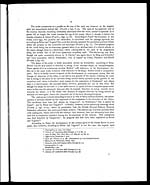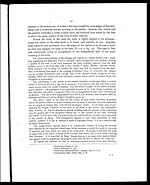Medicine - Institutions > Army health reports and medical documents > Scientific memoirs by officers of the Medical and Sanitary Departments of the Government of India > Number 12 - On the morphology, teratology, and diclinism of the flowers of cannabis > On the morphology, teratology, and diclinism of the flowers of cannabis
(16) Page 10
Download files
Individual page:
Thumbnail gallery: Grid view | List view

10
of the axis of a flower-bud is at first quite indistinguishable from the organic apex of a leaf-
bud. Soon, however, the apex in a flower-bud gives rise to the ovule; this (PLATE 3, fig. 8)
is followed shortly by the development of the involving bract (PLATE 3, fig. 9); then by the
appearance of the ovarian parietes (PLATE 3, fig. 10); last of all by the appearance of the
perianth (PLATE 3, figs. 11-14) between the involving bract and the ovary.
The Fruit.—The ripe fruit is a true nut with a hard crustaceous shell, en-
closed below in a leathery husk (PLATE 2, fig, 14) and completely filled by a fleshy
kernel. Seen from the side it has an oval outline with a subacute apex, the point
whence the styles have fallen; seen from below it is rounded towards the inner
(posterior) side, slightly ridged or crested towards the outer (anterior) side (PLATE
2, fig. 15), the ridge corresponding to the position within of the radicle. The
base shows a circular scar marking the point of attachment to the stem. In
colour the nut is greenish grey, somewhat mottled.
The nut is what is popularly known as the " seed " of hemp, used (for the sake, however,
of the contained seed), sometimes as food, especially for birds, and largely for the purpose
of expressing a fixed oil employed in various arts. Hayne1 termed the fruit an achene,
a term permissible, if the theory that the ovary is composed of one carpel be maintained,
though it hardly complies with the technical definition of an achene because the style does
not remain partially adherent. Harz2 appears to be the first to term it a nut, apparently,
however, only on the ground that it has a hard pericarp. Taking a nut technically to mean a
one-seeded fruit, enveloped in a husk, with a hard shell composed of more carpels than
one, we must in using the term accept the theory of a bicarpellary ovary. The husk is
the partially shrivelled involving bract. The mottling outside is due to the remains of the
closely applied perianth. The crustaceous character of the shell is due to the presence of
a layer of irregularly columnar cells in the endocarp, developed everywhere except opposite
the funiclus of the seed, where a small circular plug of minute rounded cells occupies the
spot which corresponds to the placenta or original point of contact of the ovule with the
ovarian wall.
The Seed.—The body of the kernel of the nut, which is the ripened seed, is
composed mainly of the plano-convex cotyledons, embracing between them a con-
siderable plumule. The upper or anterior, and somewhat smaller cotyledon is rather
closely approximated to the semicylindric radicle which is thus pseudo-incum-
bent; an invagination of the testa separates the two. The body of the seed is
close to the posterior, the radicle to the anterior wall of the seed (PLATE 2,
figs. 17-21.)
The testa covering the body of the seed is sage-green, that covering the
radicle is darker, almost olive-green; round the chalaza there is a circular patch
of orange-brown colour. Within the green testa there is a white coat, of less uni-
form thickness, covering the whole of the embryo from the micropyle to the
margin of the orange-brown chalazal patch, with which it is organically united.
This white coat is the albumen of the seed, derived from the body of the ovule
1 Arsneigewächse, viii. t. 35.
2 Landwithschaftliche Samenkunde : Berlin, 1885; p. 94.
Set display mode to: Large image | Zoom image | Transcription
Images and transcriptions on this page, including medium image downloads, may be used under the Creative Commons Attribution 4.0 International Licence unless otherwise stated. ![]()
| Permanent URL | https://digital.nls.uk/75026764 |
|---|
| Shelfmark | IP/QB.10 |
|---|---|
| Additional NLS resources: | |




